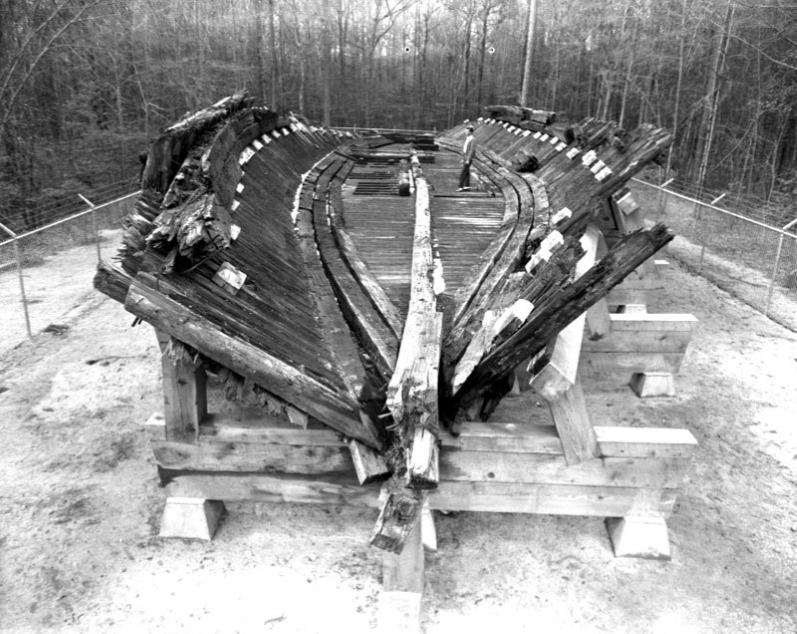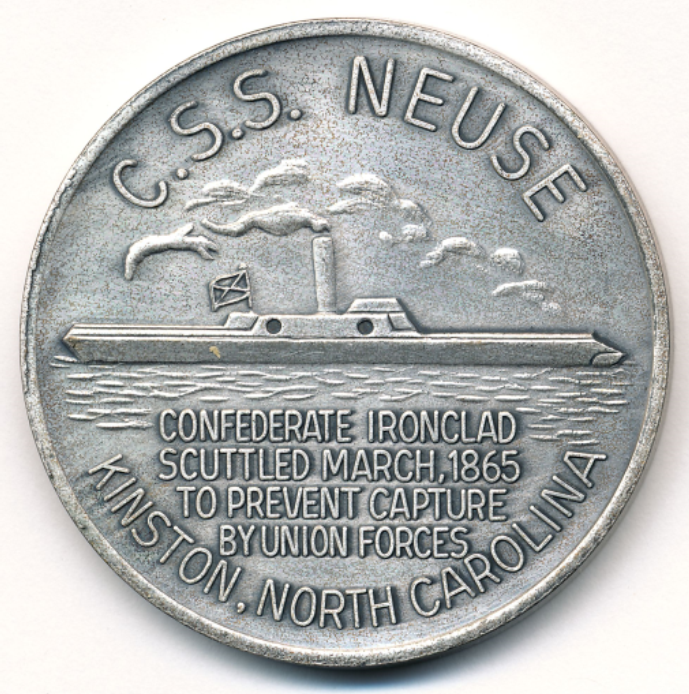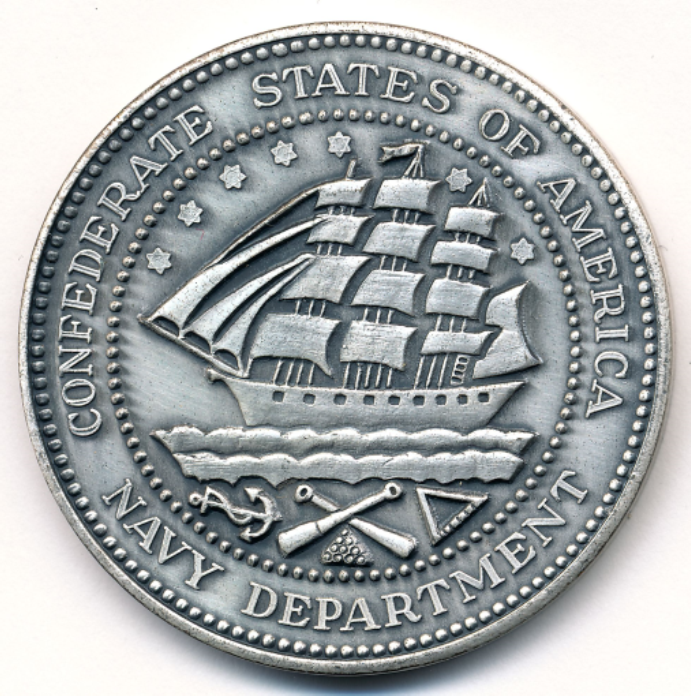The Confederate Ironclad CSS Neuse
The current commemoration of the 150th anniversary of the Civil War period has been far more muted than it was during the 1961-65 centennial years. Today’s socio-political climate has apparently made marking one of the seminal events in US history a less than popular idea. As such, there are relatively few numismatic souvenirs available to collectors.
In contrast, 50 years ago, the Civil War Centennial proved to be a fertile ground for collectors of commemorative medals and/or tokens. From the official silver and bronze medals of the Congressionally-authorized US Civil War Centennial Commission (produced by the Medallic Art Company) to the many dozens of privately-struck pieces, a 1960s collector was faced with an honest challenge if they sought to secure an example of each piece available.
Included among the North Carolina related Civil War centennial issues was a medal struck to commemorate the Confederate ironclad CSS Neuse. The medal was sponsored by the Lenoir County Confederate Centennial Committee; it was issued to help raise funds to support the recovery of the century-old warship from the bottom of the Neuse River in Kinston, NC. The recovery effort was one of the highlights of North Carolina’s Civil War centennial activities.
The wooden hull of the Neuse was built in White Hall, NC (present day Seven Springs) by the shipbuilding firm of Howard and Ellis; the construction site was about 18 miles west of Kinston. Work on the barge-like ship was begun in late 1862. From the start, however, the ship faced multiple obstacles to its completion.
First of these was an attack by Union forces shortly after construction of the ship had begun. On December 15, 1862, Union forces chased a Confederate force retreating from Kinston into White Hall and engaged them along the Neuse River. The partially-completed Neuse was spotted by the Union forces and was subsequently attacked with artillery. Though the ship was damaged by the Union attacks, the damage was not severe enough to destroy the ship. Construction resumed on the Neuse shortly after Union forces left the area on December 17, 1862 and by March 1863 it was ready to be floated down the river to Kinston where it was to receive its engines and iron plating.
Work continued on the ship through the rest of 1863, but shortages of needed materials – not the least of which were the iron sheets that were to be used to plate the ship – caused ongoing delays. Work dragged on into 1864. The Neuse, though still not fully outfitted, was called into action for the first time in April 1864 as part of a Confederate offensive to retake the town of New Bern.
Unfortunately, the ship ran aground on a sandbar in the shallow Neuse River within a half-mile of its Kinston departure point. It remained trapped until mid-May when the river rose enough to float the ship. It returned to Kinston where it was finally completed. There it waited for its next chance to take the offensive against the enemy, but such a chance never came as the Confederate troops that would be needed to provide ground support for the ship’s actions at New Bern were pulled to other areas to help defend them against Union advances.
After the fall of Fort Fisher and Wilmington in January 1865, Union forces pushed inland. On March 17, they had reached Kinston and prepared to destroy the Confederate ironclad. The crew of the Neuse was able to briefly shell the advancing Union army, but it was clear that they would not be able to protect and save the ship. The crew of the Neuse eventually evacuated the ship and then set it on fire to keep it from being taken by Union troops. The fire triggered an internal explosion of ordnance that was left on board. The explosion blew a hole in the ship’s port side that led to its sinking – a less than glorious end to a ship from which much was expected.
After the Civil War was over, the US Treasury Department held an auction for the salvage rights to the ship. The company that won the auction recovered the ship’s iron plating, guns, boiler, engine parts and other worthwhile machinery. From that point on, the ship was basically left untouched by any organized recovery effort. And so, the Neuse began to slowly deteriorate while lodged in the silt and sand at the bottom of the Neuse River.
On October 31, 1961, Henry Clay Casey and Lemuel Houston of Kinston, NC along with Tom Carlyle of Richlands, NC began using a dragline (an excavating machine that drags a bucket via a cable) to initiate the removal of the accumulation of sand and silt from around the Neuse.4 The three soon realized that the project was bigger than anticipated and that additional equipment and funds would be necessary if they were to succeed. The question of ownership of the ship’s remains also surfaced when the owners of the land adjacent to the Neuse River on which the ironclad had settled also made claim to the ship.
In 1962, the City of Kinston, the Lenoir County Board of Commissioners and the Lenoir County Confederate Centennial Committee began working together to reclaim the Neuse from its river grave. They each contributed money to the effort and also began public fundraising efforts. The goal of their efforts was to relocate the remains of the ship to a site where it could be protected, preserved and put on public display as a permanent Confederate memorial.5
The deteriorated lower hull of the Neuse was finally freed from the river bottom in the spring of 1963 by D. C. Murray, a local house mover. The nearby Governor Richard Caswell Memorial site was selected as the new home for the Neuse. To move the hull to the Caswell site, it was carefully cut into three pieces; it was estimated that the hull weighed in excess of 150 tons. The sections were moved by truck to the site and then re-assembled. The move was completed on May 25, 1964.6

Recovered remains of burned out CSS Neuse hull (ca. 1965).7

Reverse of CSS Neuse commemorative medal featuring Seal of Confederate States Navy.

The general release of the medal offered three options: 0.999 fine silver in proof, oxidized bronze and silver-oxidized bronze (the silver-oxidized medals have a pewter-like appearance). All versions are the same size, 1-17/32 inches (39 mm); they were described at the time of issue as “crown-sized.”
Mintage of the one-ounce silver proof medal was limited to 1,000; the serial-numbered medals sold for $10.00. Mintage for each of the bronze pieces was “open” but, based on current availability, likely did not exceed 3,000 for either. The oxidized bronze medals sold for $2.00 and the silver-oxidized bronze cost $3.00. The two bronze versions are considered “relic” medals as they feature metal from the recovered vessel.8 The medals were struck by Capitol Medals, Inc. of High Point, NC.
The Lenoir County Centennial Committee also took special orders for platinum medals and four-ounce silver medals. The platinum medals sold for $750.00, while the large silver pieces cost $100.00. No gold medals were available as it was illegal for Americans to own gold in such form at the time; platinum was the metal of choice for collectors desiring a “high-end” piece.
How difficult is it to find the medals today? Over the past year, I have encountered one or more of them at several of the coin shows that I attended here in North Carolina. I’ve also come across a few on on-line auction sites as well. In all cases, the selling price for each of the bronze versions was $30 or less and for the one-ounce proof silver $50.00 or less. So, for a collector with interest, obtaining the medals is certainly not an impossible pursuit.
This past summer, the Neuse was moved from its covered but otherwise outdoor home at the Caswell Memorial Site to a new indoor facility in downtown Kinston – the CSS Neuse Interpretive Center. The Center is currently open for visitors but remains a work in progress. The official opening of the facility, with all permanent exhibits in place, will be during the summer of 2014.
A full-size replica of the ironclad – the CSS Neuse II – has been constructed in Kinston by the CSS Neuse Foundation and is available for tours on Saturdays from 10:00am to 4:00pm.
For the most complete history of the CSS Neuse, I recommend the book C.S.S. Neuse: A Question of Iron and Time; this volume was the primary source for the summary of the history and background regarding the ship that I included here. An adaptation of the book’s information can be found at the North Carolina Historic Sites web site for the ship at http://www.nchistoricsites.org/neuse/.
Until next time, Happy Collecting!
— David Provost
© Copyright D. Provost 2013. All rights reserved. Used with permission.
Sources:
- “Ironclads.” NCpedia. North Carolina Department of Cultural Resources Office of Archives & History. Web. Nov. 15, 2013.
- Bright, Leslie S, William H. Rowland, and James C. Bardon. C.S..S Neuse: A Question of Iron and Time. Raleigh: North Carolina Office of Archives and History. 1981. Print.
- “The Salvage Operation.” CSS Neuse & Gov. Caswell Memorial. North Carolina Department of Cultural Resources Office of Archives & History, June 5, 2012. Web. Nov. 15, 2013.
- “Civil War Ram.” News Letter of the North Carolina Confederate Centennial Commission. November 1961: 2. Print.
- “Annals of the Neuse.” News Letter of the North Carolina Confederate Centennial Commission. December 1962: 1-2. Print.
- “Neuse Moved to Permanent Site.” News Letter of the North Carolina Confederate Centennial Commission. May 1964: 1. Print.
- “Burned out hull remnants of the Confederate ironclad gunboat CSS Neuse.” William H. Rowland Papers. JY Joyner Library; East Carolina University. http://digital.lib.ecu.edu/855.
- “Commemorative Medals Struck for Neuse.” News Letter of the North Carolina Confederate Centennial Commission. October 1963: 2. Print.



